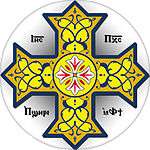Nayrouz

Nayrouz or Neyrouz is a feast when martyrs and confessors are commemorated within the Coptic Orthodox Church. Celebrated on September 11, the day is also the start of the Coptic new year and its first month, Thout.
The Feast of Neyrouz marks the first day of the Coptic year. Ignorant of the Egyptian language for the most part, the Arabs confused the Egyptian new year's celebrations, which the Egyptians called the feast of Ni-Yarouou (lit. the feast of the rivers), with the Persian feast of Nowruz,[1] from which the word Nayrouz etymologically comes from. The misnomer remains today, and the celebrations of the Egyptian new year on the first day of the month of Thout are known as the Neyrouz. Its celebration falls on the 1st day of the month of Thout, the first month of the Egyptian year, which for AD 1901 to 2098 usually coincides with 11 September, except before a Gregorian leap year when it begins September 12.
The Coptic year
The chronology of the Coptic Orthodox Church begins when Diocletian became Roman emperor in 284 AD. His reign was marked by torture of Christians to force them to deny their faith, as well as by mass executions, especially in Egypt. It is believed this time was one of the worst times that the Coptic church faced, known to believers as "the martyrdom era". Hence, the Coptic year is identified by the abbreviation A.M. (for Anno Martyrum or "Year of the Martyrs"). It should not be confused with the A.M. abbreviation used for the unrelated Jewish year, which is Anno Mundi ("year of the world").